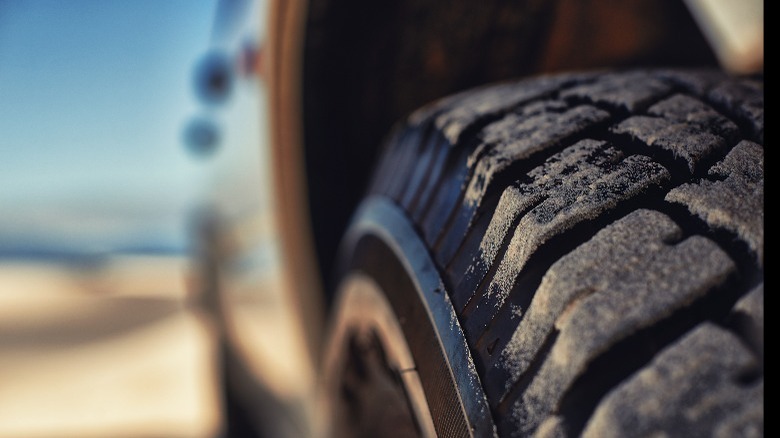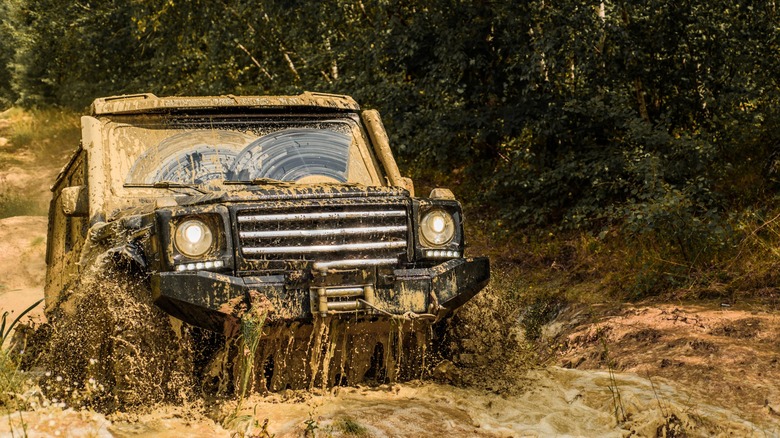4WD High Vs. Low: A Guide For When To Use Which 4x4 Mode
Since America's first four-wheel-drive truck, owning an off-road vehicle has proven to be a lot of fun. It allows you to adventure on rugged terrain and even drive safer during unpredictable weather situations. However, it's important to be knowledgeable about your vehicle's capabilities. More than likely, your off-road vehicle comes with four-wheel-drive (4WD), but there are two types of 4WD modes to be aware of.
Though many people have heard of 4WD, that doesn't mean they understand what the feature entails. Taking on a sand dune is way different than driving a snowy mountain pass. With that being said, there's more to owning a 4x4 vehicle than simply switching between modes — you must have a general understanding of what 4WD high and 4WD low are and when to use them for what situations. Moreover, knowing this information can help you protect the lifespan of the transmission along with other aspects of your off-road vehicle.
Torque, traction, and wheel slip
Before diving into what 4WD high and low are and when to use them, it's vital to understand what torque, traction, and wheel slip are when discussing your off-road vehicle. Torque is the force produced by the engine that makes the tires move the vehicle. It is necessary to have torque for any vehicle, whether you're taking off from a stop sign or climbing a hill. That means when you have your vehicle in a lower gear, more torque is sent to the wheel for power.
However, too much torque can cause wheel slip. Many know wheel slipping as skidding a vehicle's tires. If your vehicle has the appropriate amount of torque and traction, though, this won't happen. Every tire has a maximum amount of traction it can handle based on the weight and the style of tread. This traction is what gives the vehicle the proper grip on the road.
4WD high and low basics
When a vehicle is in rear-wheel drive or front-wheel drive, the torque is distributed to a single tire at a time, based on the needs of the vehicle. However, when a vehicle's 4WD is enabled, all four tires work together at the same speed because the torque is being equally divided between a tire on the front and rear axle.
4WD high and low are the two 4x4 settings to choose from when you take your vehicle off-roading. When you engage 4WD high, you are simply telling the vehicle to distribute the torque as stated above. Note that the torque does not change, but the traction capabilities do. Because a tire on the front and back axle is working, more traction is available for the vehicle. In 4WD low, the vehicle's transfer case uses lower gears which increases the torque and traction ability while dropping the speeds and RMPS.
Locking differentials are important
In lieu of rock crawling features, many newer off-road vehicles now come with electronic locking differentials, which is a necessity when using 4WD. Typically, you'll have power moving between the front and rear tires, but it can't distribute it side to side on the same axle. This is where locking differentials come into play. The front and rear lockers evenly distribute the power, allowing you to climb your way out of messy situations.
Let's say you're climbing up a rocky road and end up on three wheels. Without locking diff, the torque will travel to the tire with the least amount of resistance, which would be the tire not touching the ground. This will cause the tire on the same axle that should be doing the work to lose traction. With auto locking diff, all tires are working, so you can drive yourself out of extreme terrain with no problem.
When you should use 4WD high or low
You do not want to use your 4WD the wrong way, so it is vital to know when to engage your 4WD high or low correctly. If you are driving at higher speeds through slippery conditions, you will want to use 4WD high. You will have enough torque and traction to help pull you through tricky situations. For example, if you are driving on I-70 through the Rocky Mountains during a snowstorm, 4WD high is the way to go. Just be aware of your speed — you still won't want to drive over 55 MPH.
4WD low is great when you don't need to move quickly, but you do need to get your vehicle out of intense terrain. For example, if you are rock crawling or towing exceptionally heavy, you need that extra force to help move the off-road vehicle forward. However, do not use 4WD low to get yourself unstuck from mud or snow. The additional torque will only cause wheel spin. Due to the power being used in 4WD low, driving no faster than 15 mph is recommended.
Best practices for any 4WD usage
Whether you're using 4WD high or low, there are some practices that align with both types that you need to follow. When going from 2WD to 4WD high, unless you have to get out of the vehicle and manually enable it, you can usually switch between the two modes while in motion. However, if you need to go into 4WD low, make sure to come to a complete stop and allow the mode to fully transfer over before you start to slowly drive again.
Though you can tow with it, 4WD is mostly meant for rough terrains. This means you should not engage your 4WD while on standard dry pavement. You can damage your drivetrain. Additionally, 4WD does not assist with braking. You may find yourself in a turn and over-compensate in your braking, which can lead to an accident. It has also been proven that driving in 4WD makes drivers overconfident in their abilities, causing many to end up in a ditch. When using 4WD high or low for the first time, it's best to check your owner's manual for the correct operation procedure.





